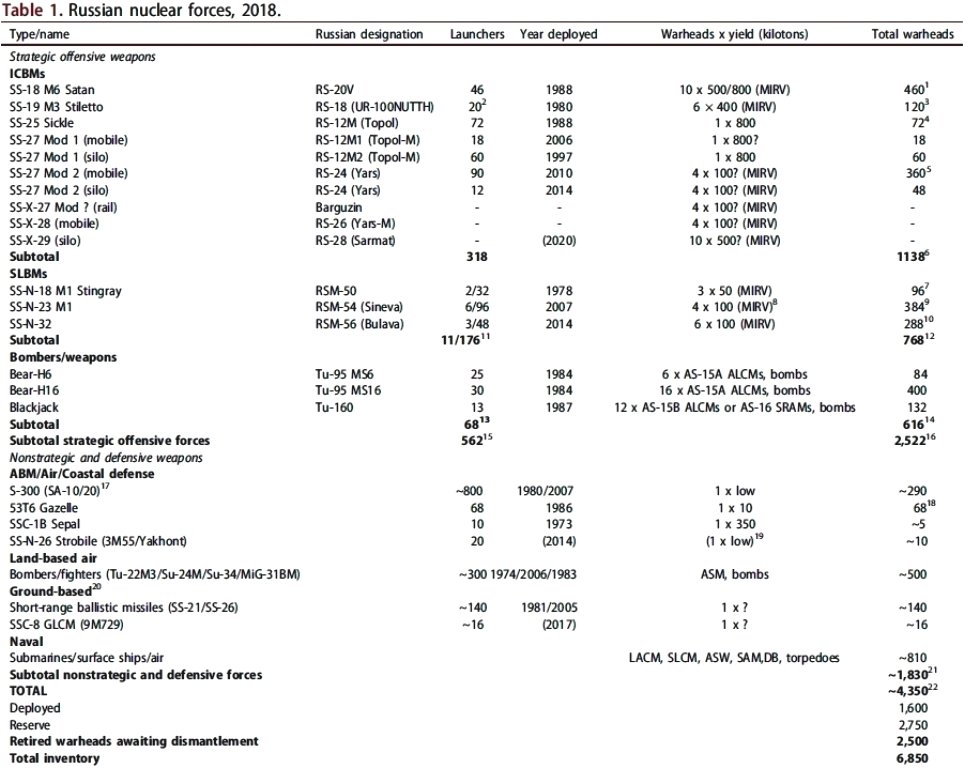Straight from the horses mouth.
February's nuclear totals.
franco wrote:https://bmpd.livejournal.com/3080655.html
Straight from the horses mouth.
February's nuclear totals.
miketheterrible wrote:franco wrote:https://bmpd.livejournal.com/3080655.html
Straight from the horses mouth.
February's nuclear totals.
So Russia even has less nukes?
That's fucking stupid.
What about tactical nukes?
miketheterrible wrote:franco wrote:https://bmpd.livejournal.com/3080655.html
Straight from the horses mouth.
February's nuclear totals.
So Russia even has less nukes?
That's fucking stupid.
What about tactical nukes?
miketheterrible wrote:franco wrote:https://bmpd.livejournal.com/3080655.html
Straight from the horses mouth.
February's nuclear totals.
So Russia even has less nukes?
That's fucking stupid.
What about tactical nukes?
franco wrote:
1 September 2018 data exchange. Russia declared 1420 deployed warheads,
. In February 2018 the numbers were 1444

George1 wrote:SIPRI Yearbook 2018
Russian Nuclear Forces

In testimony to the Senate Armed Services Committee, the head of U.S. Strategic Command said Russia is developing a nuclear-armed, nuclear-powered underwater unmanned vehicle, an intercontinental-range cruise missile, and a hypersonic nuclear weapon, which Moscow wants to keep out of existing arms agreements.
Such weapons could pose a threat in the near future if the U.S. does not counter them, Hyten warned.
“I get concerned 10 years and beyond that with torpedoes, with cruise missiles, with hypersonic, that it can go completely in the other direction, that we would have a difficulty,” Hyten said. “I have no problem saying I can defend the nation today, and I think the commander after me can, but I worry about the commander after the commander after the commander.”
Hyten also warned that Russia is improving its ability to attack anywhere in the globe with little or no notice through its pursuit of nuclear-armed hypersonic missiles and nuclear-capable cruise missiles, when coupled with the newest intercontinental-range ballistic missiles.
Hyten noted the U.S. can conduct its own research into hypersonic weapons without violating the INF Treaty, which covers ballistic missiles. He also repeated calls for a space-based sensor to defend against them. Existing U.S. sensors can detect and locate a ballistic or hypersonic missile at launch.
One difference is the hypersonic missile “disappears and we don’t see it until the effect is delivered,” Hyten said. With a ballistic missile, it would take 30 minutes to strike a target, but a with a hypersonic weapon, Hyten said, “it could be half of that.”

Austin wrote:US nuclear general worries over Russia’s weapons outside New START
https://www.defensenews.com/smr/nuclear-arsenal/2019/02/26/us-nuclear-general-worries-over-russias-weapons-outside-new-start/
In testimony to the Senate Armed Services Committee, the head of U.S. Strategic Command said Russia is developing a nuclear-armed, nuclear-powered underwater unmanned vehicle, an intercontinental-range cruise missile, and a hypersonic nuclear weapon, which Moscow wants to keep out of existing arms agreements.
Such weapons could pose a threat in the near future if the U.S. does not counter them, Hyten warned.
“I get concerned 10 years and beyond that with torpedoes, with cruise missiles, with hypersonic, that it can go completely in the other direction, that we would have a difficulty,” Hyten said. “I have no problem saying I can defend the nation today, and I think the commander after me can, but I worry about the commander after the commander after the commander.”
Hyten also warned that Russia is improving its ability to attack anywhere in the globe with little or no notice through its pursuit of nuclear-armed hypersonic missiles and nuclear-capable cruise missiles, when coupled with the newest intercontinental-range ballistic missiles.
Hyten noted the U.S. can conduct its own research into hypersonic weapons without violating the INF Treaty, which covers ballistic missiles. He also repeated calls for a space-based sensor to defend against them. Existing U.S. sensors can detect and locate a ballistic or hypersonic missile at launch.
One difference is the hypersonic missile “disappears and we don’t see it until the effect is delivered,” Hyten said. With a ballistic missile, it would take 30 minutes to strike a target, but a with a hypersonic weapon, Hyten said, “it could be half of that.”

Austin wrote:Well I have read some Russian officials stating Avangard is compliant under New START.
Nuclear powered cruise missile with unlimited range could come under New START as well because they can fly beyond 5500 km.
Posedian I am not sure as such weapons may not be part of New START.
In any case Russia should not sign any New ARMS CONTROL agreement till they have an equivalent treaty to control ABM , ARMS CONTROL and ABM go hand in hand
Russian ICBM have Upload potential so they can up the numbers if they want to.
Let INF and START go to Hell


Hole wrote:Where did this guys live the last 50+ years? Since Russia deployed the first ICBM´s there missiles were a threat to Mordor on the Potomac.

